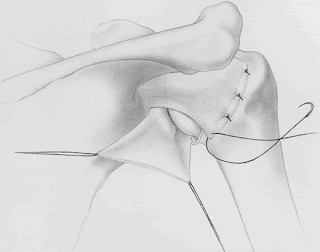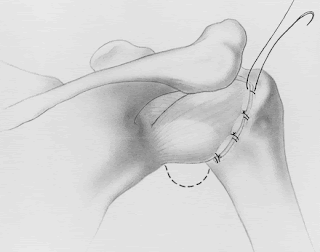For years I have selectively used arthroscopic techniques for stabilization of the shoulder for individuals who have had instability or recurrent dislocations. I have, however, been skeptical of using arthroscopic surgery alone for all patients because I do not believe it yields satisfactory long term results and is associated with a higher rate of recurrence. In other words, I believe that arthroscopic stabilization procedures have a higher rate of failure. The review of the study below confirms this, as other studies have demonstrated in the past.
I love studies that prove what I have believed for many years.
Study evaluates open, arthroscopic surgical techniques for shoulder repair
These results were presented during the American Orthopedic Society for Sports Medicine’s 2010 Specialty Day program.
Systematic reviews have evaluated whether an arthroscopic or open technique yields better results in patients with recurrent shoulder instability. They have shown that an open procedure is less likely to result in recurrent instability; however, this remains a controversial topic.
Researchers performed the largest randomized trial to date on this subject and found more evidence in favor of the open technique.
They found no difference in disease-specific quality of life in patients who received open or arthroscopic repair for traumatic anterior shoulder dislocation, but patients who underwent open repair had a significantly lower risk of recurrent instability.
An expertise-based approach
In the randomized clinical trial, 196 patients with traumatic unidirectional anterior shoulder instability underwent open (Fig. 1) or arthroscopic (Fig. 2) repair (open, n = 98; arthroscopic, n = 98). Both groups consisted of 80 males and 18 females. The mean age in the open group was 27.8 years; in the arthroscopic group, it was 27.2 years. Expertise-based randomization allowed the participating surgeons to perform their preferred surgical technique for the repairs.
| Fig. 1 A, Diagram of capsule during of open capsular repair for anterior instability. |
Bankart lesions (tears of the stabilizing cartilage structures in the shoulder) were the primary pathology, and most of the open procedures were performed using the subscapular split approach.
The researchers measured disease-specific quality of life using the Western Ontario Shoulder Instability (WOSI) Index at baseline and at 3, 6, and 12 months postoperatively. They compared mean WOSI scores using an independent sample t-test.
Secondary outcome measures included range-of-motion, recurrent instability, surgical time, and scores from the American Shoulder and Elbow Surgeons (ASES) questionnaire. Patients were followed for a minimum of 1 year, and identical rehabilitation protocols were used.
Comparing outcomes
Investigators analyzed baseline characteristics and found no statistically significant differences regarding gender distribution, operative side, hand dominance, age, participation in sports, or WOSI scores between the two groups. On average, arthroscopic procedures were completed in 1 hour and 1 minute, while the open procedures took an average of 1 hour and 17 minutes.
At 12 months postoperatively, 175 patients (84 open, 91 arthroscopic) had completed follow-up. Researchers found no statistical difference in average WOSI scores, ASES scores, or range of motion between the two groups.
A statistically significant difference was found in instability recurrence rates (open, 4 percent; arthroscopic, 12 percent; p = 0.042).
Younger age and the presence of a Hill Sachs lesion were two factors related to recurrence.
All patients with recurrent instability had a Hill Sachs lesion (this is a fracture of the humeral head from the dislocation). The average age of patients with recurrence was 22 years, compared to 27 years in the total study population.
Overall, researchers concluded that there is no disease-specific quality of life difference between open and arthroscopic repairs, but that open surgical repair has a statistically lower chance of recurrent instability and a trend toward better disease-specific outcomes.
Bottom line
- Both open and arthroscopic approaches for treating traumatic anterior shoulder dislocation have similar functional and quality of life outcomes.
- Using an open, rather than arthroscopic, technique results in a lower rate of recurrence in patients with recurrent shoulder instability.
- The presence of a Hill Sachs lesion and younger age are likely associated with recurrent instability.
AAOS Now
May 2010 Issue
http://www.aaos.org/news/aaosnow/may10/clinical11.asp
May 2010 Issue
http://www.aaos.org/news/aaosnow/may10/clinical11.asp
Thanks,
JTM, MD

